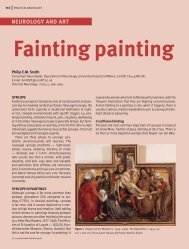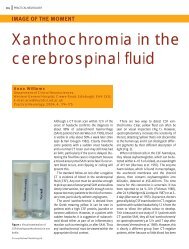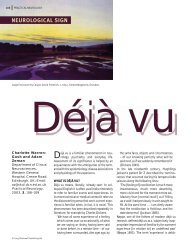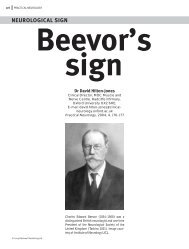The carotid bruit - Practical Neurology
The carotid bruit - Practical Neurology
The carotid bruit - Practical Neurology
Create successful ePaper yourself
Turn your PDF publications into a flip-book with our unique Google optimized e-Paper software.
222<br />
PRACTICAL NEUROLOGY<br />
Table 1 When is neck ausculation clinically useful?<br />
Situations when the presence or absence of a <strong>carotid</strong> <strong>bruit</strong> can be helpful<br />
In patients over 50 years of age with recent <strong>carotid</strong> territory TIA or stroke<br />
– a <strong>bruit</strong> over the symptomatic <strong>carotid</strong> artery suggests the possibility of an<br />
underlying severe stenosis, likely to benefi t from surgery<br />
– a <strong>bruit</strong> may indicate stroke or TIA is more likely due to atherosclerosis than some<br />
other nonatheromatosis pathophysiological process<br />
In patients with history of sudden onset of focal neurological signs (transient or<br />
persistent)<br />
– the presence of a <strong>bruit</strong> increases the probability that the symptoms were<br />
vascular in origin<br />
In younger patients with sudden focal symptoms (transient or persistent) where a<br />
vascular cause is thought unlikely (e.g. clinical syndrome of migraine aura without<br />
headache)<br />
– absence of a <strong>bruit</strong> makes underlying vascular disease even less likely.<br />
Situations where it may be better not to auscultate the neck<br />
Asymptomatic individuals<br />
Patients with nonfocal neurological symptoms<br />
– blackouts<br />
– dizzy turns<br />
– headaches<br />
Patients with pulsatile tinnitus<br />
Figure 2 <strong>The</strong> sites of maximal<br />
intensity of arterial <strong>bruit</strong>s in<br />
the neck. A <strong>bruit</strong> arising from<br />
the <strong>carotid</strong> bifurcation is high<br />
up under the angle of the jaw.<br />
Localized supraclavicular <strong>bruit</strong>s<br />
are caused either by subclavian<br />
or vertebral origin artery stenosis.<br />
Diffuse <strong>bruit</strong>s are transmitted<br />
from the arch of the aorta or the<br />
heart.<br />
© 2002 Blackwell Science Ltd<br />
neurological practice. <strong>The</strong>n, get the patient into<br />
a quiet room, in a relaxed and comfortable position.<br />
We use the diaphragm of the stethoscope,<br />
because it detects the higher frequency sounds<br />
of arterial <strong>bruit</strong>s rather better than the bell. Ask<br />
the patient to breathe in and hold their breath.<br />
Listen over an area beginning from just behind<br />
the upper end of the thyroid cartilage to just<br />
below the angle of the jaw, in other words over<br />
the line of the common <strong>carotid</strong> artery leading up<br />
to the bifurcation into the internal and external<br />
<strong>carotid</strong> arteries. Apply only suffi cient pressure<br />
to ensure the diaphragm rests squarely on the<br />
skin (Fig. 1). Excessive pressure can compress<br />
the underlying artery enough to cause a <strong>bruit</strong><br />
even when the artery is normal.<br />
THE BRUIT THAT MATTERS: THE<br />
ONE DUE TO CAROTID STENOSIS<br />
Bruits at the bifurcation of the common <strong>carotid</strong><br />
artery are best heard high up under the angle of<br />
the jaw (Fig. 2). At this level the common <strong>carotid</strong><br />
artery bifurcates and gives rise to its internal<br />
branch. If one hears a <strong>bruit</strong> only in the base of<br />
the neck, or along the course of the common<br />
<strong>carotid</strong> artery, it is referred to as ‘diffuse’. Diffuse<br />
<strong>bruit</strong>s are not a very specifi c indicator of internal<br />
<strong>carotid</strong> artery disease. Bruits heard only at the<br />
bifurcation are more specifi c for internal <strong>carotid</strong><br />
artery origin stenosis, but lack sensitivity. Unfortunately<br />
<strong>bruit</strong>s at this location can also arise<br />
from disease of the external <strong>carotid</strong> artery.<br />
OTHER NOISES IN THE NECK<br />
See Table 2. Bruits transmitted from the heart<br />
become attenuated as one moves the stethoscope<br />
up the neck towards the angle of the jaw. Thyroid<br />
<strong>bruit</strong>s are bilateral and more obviously located<br />
over the gland. A hyperdynamic circulation tends<br />
to cause a diffuse and bilateral <strong>bruit</strong>. Venous hums<br />
are caused by fl ow in the internal jugular vein.<br />
<strong>The</strong>y are continuous and roaring and are obliterated<br />
by light pressure over the ipsilateral jugular<br />
vein. <strong>The</strong>se are found in over 25% of young people<br />
but can be distinguished from <strong>bruit</strong>s by their disappearance<br />
with the Valsava manoeuvre. Venous<br />
hums are rarely heard with the patient lying down.<br />
An arterial <strong>bruit</strong> in the supraclavicular fossa suggests<br />
either subclavian or proximal vertebral arterial<br />
disease, but a transmitted <strong>bruit</strong> from aortic<br />
stenosis must also be considered. Normal young<br />
adults quite often have a short supraclavicular<br />
<strong>bruit</strong>; the reason is unknown.<br />
DEGREE OF CAROTID STENOSIS<br />
AND CHARACTER OF THE BRUIT<br />
With modest arterial stenosis or irregularity, any







